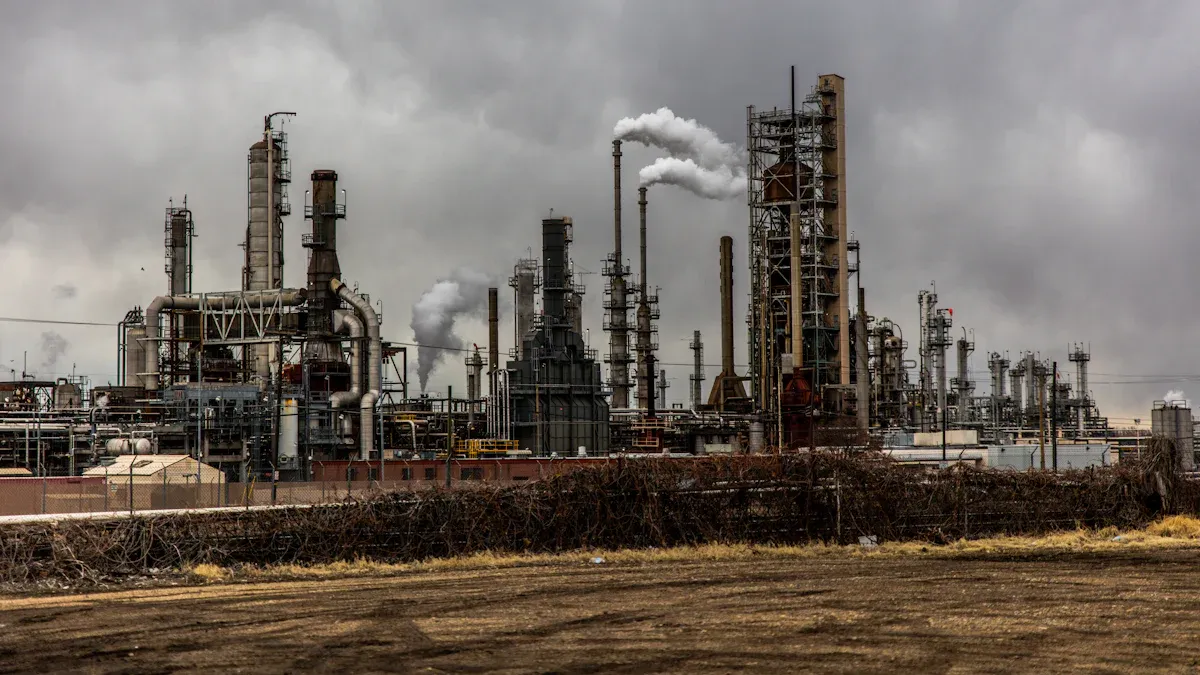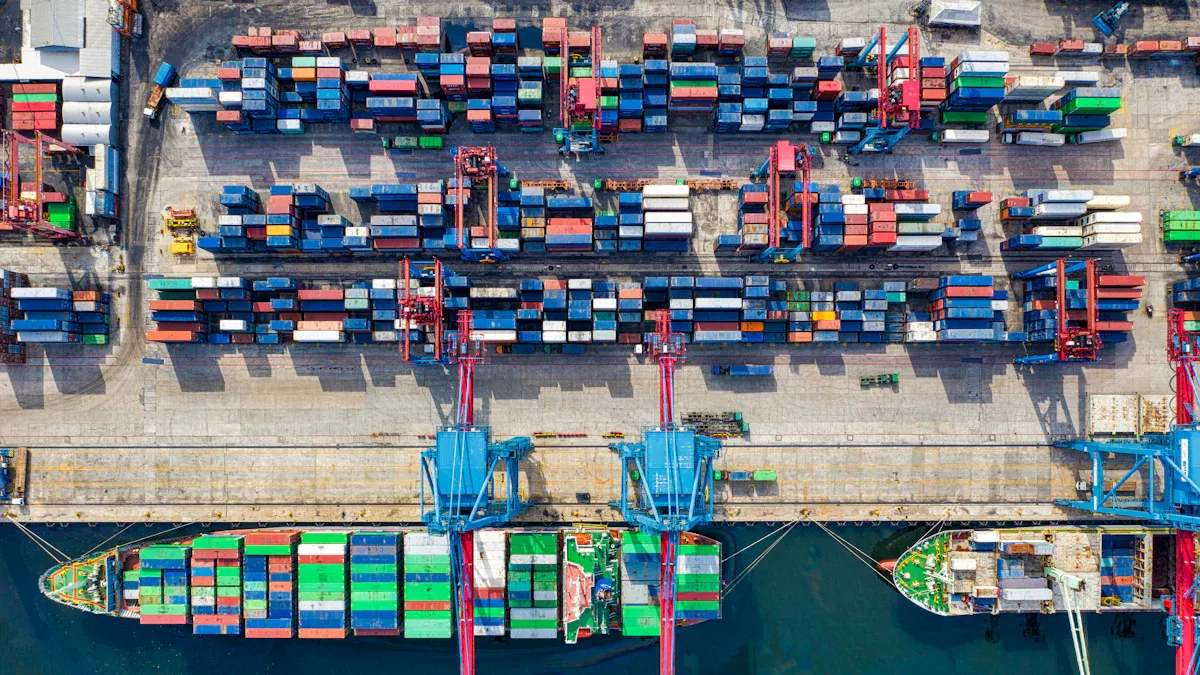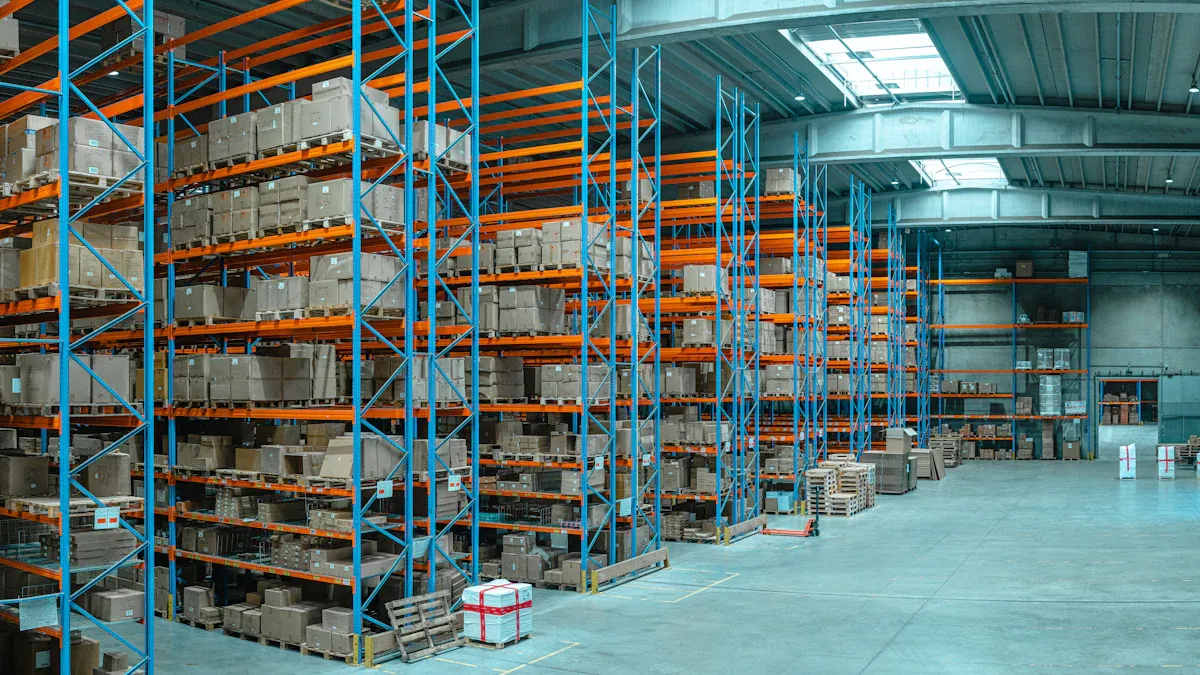How to Boost Efficiency in Chemical Logistics Operations

You can achieve chemical logistics efficiency improvement by using integrated approaches that combine technology, process mapping, safety audits, and staff training.
Quick wins include adopting AI and IoT tools for real-time tracking, mapping workflows, and building strong collaborations.
The chemical logistics market is growing fast, with new technology and green logistics making operations smoother.
Companies boost efficiency by diversifying supply chains, using advanced tracking, and expanding distribution.
Strategy | Benefit |
|---|---|
Predict problems, speed up shipping | |
Upgraded tracking/inventory | Improve operations |
Diversified partnerships | Avoid delays, keep things moving |
Key Takeaways
Use integrated approaches combining technology, process mapping, and collaboration to enhance chemical logistics efficiency.
Implement real-time tracking tools to monitor shipments and inventory, allowing for quick responses to disruptions.
Foster strong partnerships with stakeholders to streamline processes and improve service reliability.
Adopt automation in warehouses to reduce labor costs, minimize errors, and increase overall efficiency.
Invest in ongoing staff training to ensure safety and keep your team updated on new technologies and regulations.
Integrated Chemical Logistics Efficiency Improvement
You can boost chemical logistics efficiency improvement by using an integrated approach. This means you combine technology, process mapping, and stakeholder collaboration. When you use these strategies together, you make your operations faster, safer, and more reliable.
Map and Document Workflows
Start by mapping and documenting your workflows. This step helps you see every part of your process. You can use different techniques to make your workflow clear. Here is a table showing common mapping methods and their results:
Technique | Description |
|---|---|
Flowcharts | Visual representation of the steps in a process, helping to identify inefficiencies and streamline workflows. |
SIPOC Diagrams | High-level overview of a process, detailing Suppliers, Inputs, Process, Outputs, and Customers, aiding in understanding the entire workflow. |
BPMN | Business Process Model and Notation, used for modeling and documenting business processes in a standardized way. |
Spaghetti Diagrams | Visual tool to illustrate the physical flow of materials and information, highlighting inefficiencies in layout and movement. |
When you map your workflows, you find gaps and bottlenecks. You can fix these problems and make your process smoother. Capability mapping also helps you align your technology and resources with your business goals. This alignment leads to better chemical logistics efficiency improvement. You create a strong foundation for continuous improvement and transformation.
End-to-End Visibility Tools
End-to-end visibility tools let you see your entire supply chain in real time. You can track shipments, monitor inventory, and plan for changes. These tools use GPS, RFID, and data analytics to give you control over your operations.
"What you need is a unified, digital model of your entire supply chain—not just one plant or region, but your entire operational network. Cracking units, campaign plans, batch production flows, inventory positions, customer demand, and contract constraints are all considered in one platform. With this level of visibility, you don’t just react. You plan proactively, with confidence."
"Imagine this: one of your planners runs multiple overnight simulations — one for a polyethylene production cutback due to market oversaturation, another exploring the impact of a sudden shipping delay, and a third modeling carbon pricing fluctuations. Before, these kinds of assessments could take weeks because they relied on manual data gathering, siloed spreadsheets, and lengthy cross-team discussions. Now, with integrated scenario planning, the same analysis can be completed overnight and reviewed the next morning."
"The earlier you gain visibility, the better you can respond to—or even avoid—disruptions," says Christian Titze, vice president, analyst, and chief of research with Gartner.
"Real-time tracking and intelligence can provide the agility needed to help firms quickly pivot sourcing or shipping plans when trade policies change or political events disrupt logistics," he adds.
You can use these tools to respond quickly to problems. You avoid delays and keep your chemical logistics efficiency improvement on track.
Stakeholder Collaboration
Collaboration with stakeholders is key to success. You need to work with chemical manufacturers, logistics providers, and customers. When you build strong partnerships, you solve problems faster and improve service.
Here are some examples of successful collaboration:
Company | Description |
|---|---|
Odyssey Logistics | Collaborated with a chemical company to automate a manual sampling process, improving customer satisfaction and reducing costs. |
LMR | Partnered with carriers to provide 24/7 support, taking ownership of client issues to enhance service reliability. |
Collaboration among stakeholders can lead to a 25% improvement in overall supply chain performance.
You streamline processes and reduce costs when you work together.
Long-term partnerships help you optimize production and reduce wasted resources.
You can use automation, real-time tracking, and compliance management to support collaboration. Blockchain technology also helps you build trust and transparency in your supply chain. When you combine these tools and strategies, you achieve chemical logistics efficiency improvement and set your business up for growth.
Optimize Transport and Route Planning

Dynamic Routing
You can make your deliveries faster and more reliable by using dynamic routing. This method lets you adjust routes in real time. You track vehicles and shipments with GPS and RFID. Smart routing technology gives you live updates and performance dashboards. These tools help you avoid traffic, weather delays, and other problems. When you use dynamic routing, you get accurate delivery times and shorter delivery windows. This makes your customers happier and helps you stay ahead of your competitors. Dynamic routing also improves safety by letting you change routes if there are risks, like bad weather or road closures.
Tip: AI and advanced data analytics can predict the best routes by looking at traffic, demand, and even weather patterns.
Bulk Shipment Preparation
Bulk shipment preparation helps you save money and time. You can combine shipments to fill up trucks or containers. This reduces the number of trips and lowers transportation costs. Sharing accurate product information with your carriers ensures safe and proper handling. Using technology to track and manage shipments makes your operations smoother. Here are some steps you can follow:
Consolidate shipments to maximize load capacity.
Share correct product details with your transport partners.
Use tracking tools to monitor shipments.
Bulk shipment preparation leads to better load management and fewer mistakes. You use your resources more efficiently and cut down on expenses.
Regulatory Compliance
You must follow strict rules when moving chemicals. These rules protect people and the environment. Common challenges include hazardous materials regulations, customs compliance, and environmental standards. Each challenge can slow down your shipments if you do not prepare well. Here is a table showing how these challenges affect efficiency:
Challenge | Impact on Efficiency |
|---|---|
Hazardous Materials Regulations | Needs careful training and documentation. Mistakes can cause delays or fines. |
Customs Compliance | Requires correct paperwork. Errors lead to shipment delays or penalties. |
Environmental Regulations | Demands green technology and standards. Non-compliance can hurt your reputation. |
Keeping paperwork accurate takes time, and even small errors can cause big delays. You can use automation and digital tools to manage documents and stay compliant. This approach supports chemical logistics efficiency improvement and keeps your shipments moving smoothly.
Advanced Tracking and Safety Systems
Real-Time Tracking
You can make your chemical shipments safer and more efficient with real-time tracking systems. These tools let you see where your products are at any moment. You can monitor temperature, track travel routes, and check the safety of your fleet. Real-time tracking helps you respond quickly to problems and make smart decisions when something unexpected happens. You also get more transparency across your entire operation.
Reduces the risk of incidents
Optimizes decision-making in unforeseen events
Increases transparency of the entire operation
Tracks travel routes
Ensures a safe fleet
Tip: Real-time tracking gives you the power to spot issues before they become big problems.
Safety Audits and Inspections
Regular safety audits and inspections help you keep your workplace safe and your shipments secure. You can find hazards and unsafe practices before they cause trouble. Safety audits also help you follow health and safety rules. When you identify risks early, you lower the chance of accidents and protect your team. A safer workplace means your employees work better and faster. You also save money by avoiding costly incidents and lowering insurance costs.
Impact Area | Description |
|---|---|
Workplace Safety | Regular audits enhance workplace safety by identifying potential hazards and unsafe practices. |
Compliance | They ensure compliance with health and safety regulations, fostering a safer work environment. |
Accident Reduction | Proactively identifying risks contributes to a significant reduction in workplace accidents. |
Organizational Efficiency | A safer workplace leads to increased productivity and efficiency among employees. |
Financial Protection | Identifying risks helps avoid costly incidents and can reduce insurance premiums. |
Packaging and Condition Monitoring
Smart packaging and condition monitoring protect your chemical products during transport. You can use sensors to check temperature, humidity, and shock. These systems help you keep chemicals stable and prevent spoilage. If something goes wrong, you get alerts and can act fast. You can redirect shipments or replace products before you lose money.
Smart packaging includes sensors that monitor temperature, humidity, and shock
Real-time data helps prevent spoilage and ensures compliance with safety regulations
Maintaining the correct temperature keeps liquid chemicals stable
Properly securing loads prevents spills, leaks, or accidents
Cold chain monitoring keeps temperature-sensitive products safe
Real-time monitoring allows for immediate corrective actions
You improve chemical logistics efficiency improvement when you use advanced tracking and safety systems. You keep your products safe, avoid losses, and make your operations run smoothly.
Streamline Warehouse and Inventory

Automation Tools
You can make your warehouse run faster and safer by using automation tools. These tools help you move, store, and track chemicals with less effort. Automated systems handle heavy objects and reduce the risk of accidents. You also cut down on mistakes and save money on labor. When you use automation, your team can focus on important tasks instead of manual work.
Here is a table showing how automation tools impact your warehouse:
Impact Area | Description |
|---|---|
Labor Costs | Automation lowers labor expenses and lets your team focus on meaningful work. |
Error Rates | Automated systems reduce mistakes in handling materials and improve safety. |
Efficiency | Automation speeds up processes and keeps inventory accurate. |
Safety | Machines handle heavy lifting, making your warehouse safer for everyone. |
You can also use high-density storage solutions, like vertical racks and automated retrieval systems, to store more chemicals in less space. This helps you handle hazardous materials safely and efficiently.
Just-in-Time Inventory
Just-in-time inventory means you keep only what you need, when you need it. You avoid overstocking and reduce waste. This method helps you save space and money. You also lower the risk of storing dangerous chemicals for too long. When you use just-in-time inventory, you respond quickly to changes in demand.
Tip: Advanced inventory management systems, like those using IoT and RFID, give you real-time updates. You always know what you have and what you need.
Barcode and RFID Systems
Barcode and RFID systems make your inventory more accurate and easier to track. You can scan items quickly and get instant information about their location and quantity. RFID tags work even when you cannot see them, so you can scan many items at once. These tags also last longer and handle tough warehouse conditions.
RFID tags give you real-time, accurate data on item location and quantity.
Automated counting reduces manual work and mistakes.
You get detailed information, like batch numbers and expiration dates, which helps you follow safety rules.
RFID scanning works without direct line of sight and can read many tags at once.
These systems can improve your inventory accuracy by up to 13%.
When you use barcode and RFID systems, you make your warehouse smarter and your chemical logistics safer.
Data Analytics and Staff Training
Performance Metrics Analysis
You can use data analytics to find problems and make better decisions in chemical logistics. Data analytics helps you streamline your processes, reduce costs, and improve how your operation runs. Advanced tools like predictive analytics and machine learning give you insights to optimize your workflow. AI-driven analytics can predict bottlenecks and lower unplanned downtime by 20%. Machine learning helped a major refinery boost throughput by 15%. IoT sensors let you monitor shipments all the time, so you can keep shipments safe and routes efficient.
Here is a table showing how performance metrics analysis tools help you make proactive decisions:
Feature | Benefit |
|---|---|
Real-time insights | Enables identification of bottlenecks and optimization of processes. |
Timely access to critical data | Supports informed decision-making to improve service levels and reduce costs. |
Focused reporting and analytics | Provides insights for proactive decisions that lower transportation costs. |
Performance measurement | Allows examination of shipment performance to direct attention where needed. |
Supply chain visibility tools | Enhances transparency and supports proactive decision-making in logistics operations. |
Ongoing Training Programs
You need strong training programs to keep your team safe and efficient. A leading chemical logistics company created a training program with safety lessons, regulatory education, and hands-on practice. This program led to a 20% drop in incidents and a 15% boost in efficiency. Specialized training helps your staff follow rules and work safely. When your team knows what to do, you avoid mistakes and keep your operation running smoothly.
Tip: Regular training sessions help your team stay updated on new safety standards and technology.
Continuous Improvement Culture
You can build a culture of continuous improvement to keep your business growing. This culture makes your team more agile and ready for change. It helps your company bounce back from challenges and focus on making processes better. When you encourage improvement, you increase efficiency and expand your production capacity. Continuous improvement supports chemical logistics efficiency improvement and helps you stay ahead in the market.
Increased agility lets you adapt quickly.
Resilience helps you overcome problems.
Process optimization boosts efficiency and capacity.
You can boost chemical logistics efficiency improvement by using integrated solutions, advanced technology, and strong partnerships. Real-time tracking, automation, and data analytics help you control shipments and reduce mistakes. Specialized training and UN-certified packaging keep your team and products safe.
You see better efficiency, lower costs, and happier customers.
You streamline operations and save money.
Assess your current processes.
Choose the most impactful changes.
Start with quick wins for immediate results.
Take action today to make your chemical logistics safer and more efficient.
FAQ
What is the fastest way to improve chemical logistics efficiency?
Start by mapping your workflows and using real-time tracking tools. These steps help you spot problems quickly and fix them before they grow.
How does technology help with chemical logistics?
You use technology like RFID, GPS, and automation to track shipments, manage inventory, and reduce errors.
Real-time data
Fewer mistakes
Faster deliveries
Why is staff training important in chemical logistics?
Staff training keeps your team safe and efficient. You learn new safety rules and how to use new tools.
Benefit | Result |
|---|---|
Fewer accidents | Safer work |
Better skills | Faster tasks |
How can you ensure safety during chemical transport?
You use regular safety audits, smart packaging, and real-time monitoring.
Tip: Always check that your team follows safety rules and uses the right equipment.
See Also
Enhancing Global Operations Through Innovative Logistics Strategies
Streamlined Inventory Management Through Top Global Logistics Services
Simplifying Supply Chain Efficiency With American Logistics Solutions
Key Strategies For Effective Management Of Global Logistics
Boosting Global Efficiency With Point-to-Point Logistics Systems
